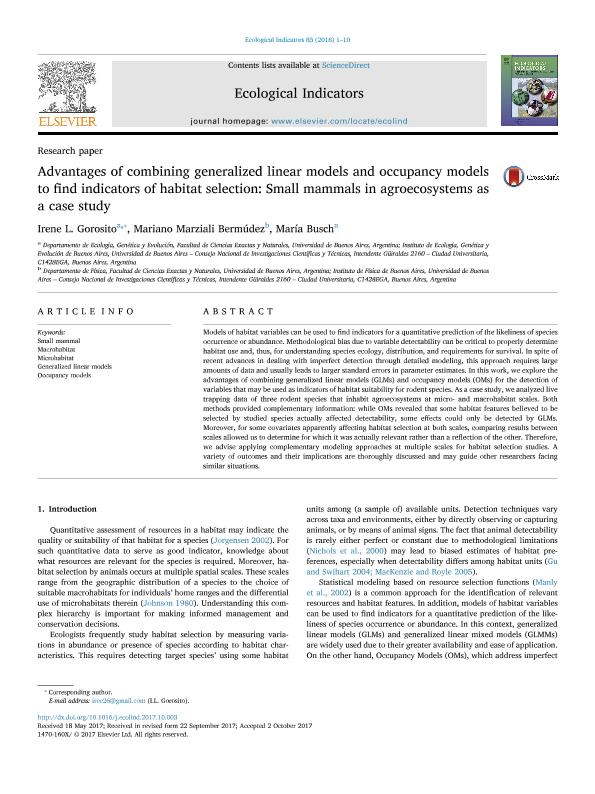Mostrar el registro sencillo del ítem
dc.contributor.author
Gorosito, Irene Laura

dc.contributor.author
Marziali Bermudez, Mariano

dc.contributor.author
Busch, Maria

dc.date.available
2019-10-11T15:11:09Z
dc.date.issued
2018-05
dc.identifier.citation
Gorosito, Irene Laura; Marziali Bermudez, Mariano; Busch, Maria; Advantages of combining generalized linear models and occupancy models to find indicators of habitat selection: Small mammals in agroecosystems as a case study; Elsevier Science; Ecological Indicators; 85; 5-2018; 1-10
dc.identifier.issn
1470-160X
dc.identifier.uri
http://hdl.handle.net/11336/85703
dc.description.abstract
Models of habitat variables can be used to find indicators for a quantitative prediction of the likeliness of species occurrence or abundance. Methodological bias due to variable detectability can be critical to properly determine habitat use and, thus, for understanding species ecology, distribution, and requirements for survival. In spite of recent advances in dealing with imperfect detection through detailed modeling, this approach requires large amounts of data and usually leads to larger standard errors in parameter estimates. In this work, we explore the advantages of combining generalized linear models (GLMs) and occupancy models (OMs) for the detection of variables that may be used as indicators of habitat suitability for rodent species. As a case study, we analyzed live trapping data of three rodent species that inhabit agroecosystems at micro- and macrohabitat scales. Both methods provided complementary information: while OMs revealed that some habitat features believed to be selected by studied species actually affected detectability, some effects could only be detected by GLMs. Moreover, for some covariates apparently affecting habitat selection at both scales, comparing results between scales allowed us to determine for which it was actually relevant rather than a reflection of the other. Therefore, we advise applying complementary modeling approaches at multiple scales for habitat selection studies. A variety of outcomes and their implications are thoroughly discussed and may guide other researchers facing similar situations.
dc.format
application/pdf
dc.language.iso
eng
dc.publisher
Elsevier Science

dc.rights
info:eu-repo/semantics/openAccess
dc.rights.uri
https://creativecommons.org/licenses/by-nc-nd/2.5/ar/
dc.subject
GENERALIZED LINEAR MODELS
dc.subject
MACROHABITAT
dc.subject
MICROHABITAT
dc.subject
OCCUPANCY MODELS
dc.subject
SMALL MAMMAL
dc.subject.classification
Ecología

dc.subject.classification
Ciencias Biológicas

dc.subject.classification
CIENCIAS NATURALES Y EXACTAS

dc.title
Advantages of combining generalized linear models and occupancy models to find indicators of habitat selection: Small mammals in agroecosystems as a case study
dc.type
info:eu-repo/semantics/article
dc.type
info:ar-repo/semantics/artículo
dc.type
info:eu-repo/semantics/publishedVersion
dc.date.updated
2019-10-09T20:44:58Z
dc.journal.volume
85
dc.journal.pagination
1-10
dc.journal.pais
Países Bajos

dc.journal.ciudad
Amsterdam
dc.description.fil
Fil: Gorosito, Irene Laura. Consejo Nacional de Investigaciones Científicas y Técnicas. Oficina de Coordinación Administrativa Ciudad Universitaria. Instituto de Física de Buenos Aires. Universidad de Buenos Aires. Facultad de Ciencias Exactas y Naturales. Instituto de Física de Buenos Aires; Argentina
dc.description.fil
Fil: Marziali Bermudez, Mariano. Consejo Nacional de Investigaciones Científicas y Técnicas. Oficina de Coordinación Administrativa Ciudad Universitaria. Instituto de Física de Buenos Aires. Universidad de Buenos Aires. Facultad de Ciencias Exactas y Naturales. Instituto de Física de Buenos Aires; Argentina
dc.description.fil
Fil: Busch, Maria. Consejo Nacional de Investigaciones Científicas y Técnicas. Oficina de Coordinación Administrativa Ciudad Universitaria. Instituto de Física de Buenos Aires. Universidad de Buenos Aires. Facultad de Ciencias Exactas y Naturales. Instituto de Física de Buenos Aires; Argentina
dc.journal.title
Ecological Indicators

dc.relation.alternativeid
info:eu-repo/semantics/altIdentifier/url/http://linkinghub.elsevier.com/retrieve/pii/S1470160X17306271
dc.relation.alternativeid
info:eu-repo/semantics/altIdentifier/doi/http://dx.doi.org/10.1016/j.ecolind.2017.10.003
Archivos asociados
